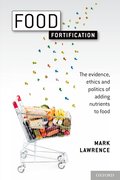By Mark Lawrence
Today (16 October 2013) is World Food Day and it’s sobering to think that globally more than two billion people are affected by micronutrient malnutrition, most commonly presenting as vitamin A deficiency, iron deficiency, anaemia, and iodine deficiency disorders. Alleviating micronutrient malnutrition is now firmly on the agendas of United Nations agencies and countries around the world.
Food fortification, that is the addition of one or more nutrients to a food whether or not they are normally contained in the food, is receiving much attention as a potential solution for preventing or correcting a demonstrated nutrient deficiency. It is a powerful technology for rapidly increasing the nutrient intake of populations. Political agendas and technological capacities are combining to significantly increase the number of staple foods that are being fortified, the number of added nutrients they contain and their reach. Across the world approximately one third of the flour processed in large roller mills is now being fortified.
Yet food fortification is a complex and contested technological intervention. Proponents of food fortification point to the ability of this technology to be introduced relatively quickly and delivered efficiently through centralised food systems to increase an individual’s nutrient exposure without the need for dietary behaviour change. Public-private partnerships involving collaborations between governments and the private sector are substantially increasing the capacity of governments to develop and implement food fortification interventions around the world. For example, the Global Alliance for Improved Nutrition (GAIN) is the primary vehicle globally brokering among governments, non-government organisations, the private sector, and civil society to promote food fortification. GAIN receives funding from a number of public and private sector donors, including the Bill and Melinda Gates Foundation and USAID.
Those who are more cautious about food fortification highlight that there are alternative policy interventions available to correct nutrient deficiencies. There are public health, social, and agriculture development measures available to promote food security and healthy dietary behaviours. For example, the Food and Agriculture Organization has proclaimed that “Sustainable Food Systems for Food Security and Nutrition” will be the focus of World Food Day in 2013. Some suggest that food fortification policy decisions should be made with regard to uncertainties about scientific evidence and ethical considerations. Scientific uncertainties relate to the public heath effectiveness as well as safety implications of food fortification. Ethical considerations – associated with increasing nutrient exposure resulting from food fortification – relate to balancing the rights of individuals, population groups and the population as a whole. How do we decide when to select food fortification and/or an alternative policy intervention as the preferred approach to tackle inadequate nutrient intake within a population?

It is my view that an evidence-informed approach to food fortification policy-making starts with the recognition that not all causes of inadequate nutrient intake are the same. Too often food fortification policy is made because of the perception it offers a relatively easy and immediate quick fix to a health problem resulting from an inadequate nutrient intake, irrespective of the cause of the inadequacy. A failure to consider the underlying cause of an inadequate nutrient intake risks putting in place an ineffective policy intervention, or worse, one that carries safety concerns as well as adverse ethical implications.
Successful food fortification interventions have been those where the technology has been used to directly tackle the underlying cause of an inadequate nutrient intake such as addressing inherent nutrient deficiencies in the food supply. For example, universal salt iodization has been highly effective in reducing the prevalence of iodine deficiency disorders around the world with minimal risks (when implemented in accordance with policy guidelines) and minimal adverse ethical implications.
Conversely, potential health risks and adverse ethical implications have resulted when food fortification policies have been developed and implemented with a lack of consideration of the underlying cause of an inadequate nutrient intake. For example, mandatory flour fortification with folic acid has been implemented in approximately 70 countries around the world as an intervention to reduce the prevalence of neural tube defects (NTDs). This policy intervention has been based on compelling epidemiological evidence that folic acid can reduce the risk of a relatively small number of women experiencing a NTD-affected pregnancy. However, NTDs have an uncertain multifactorial aetiology in which genetics plays a major role. What the evidence also shows is that for the small number of women who may be genetically predisposed to a raised folic acid requirement, folic acid is exerting its protective influence by acting more as a therapeutic agent than as a conventional nutrient. In these circumstances targeted folic acid supplementation or voluntary flour fortification with folic acid are policy interventions that are more directly tackling the underlying genetic cause of the policy problem. These policy interventions are associated with less health risks and adverse ethical implications than mandatory flour fortification with folic acid. The mandatory fortification policy intervention results in the exposure of everyone in the population who consumes flour, including infants, children, teenagers, men and older adults, to a lifetime of raised synthetic folic acid despite little evidence of any health benefit, but possible harm.
In the future, food fortification interventions look set to become progressively more widespread. Ongoing monitoring and evaluation of the impact of individual and collective food fortification activities on the nutrient composition of foods, population nutrient intakes, health outcomes, and food system operations, will be critical to inform policy and practice to protect and promote public health.
Mark Lawrence is an Associate Professor of Public Health Nutrition in the Population Health Strategic Research Centre at Deakin University. His latest book is Food Fortification: The evidence, ethics, and politics of adding nutrients to food (Oxford University Press).
Subscribe to the OUPblog via email or RSS.
Subscribe to only health and medicine articles on the OUPblog via email or RSS.
Image credit: apple filled with pills – vitamins concept. © diosmic via iStockphoto.



Recent Comments
There are currently no comments.